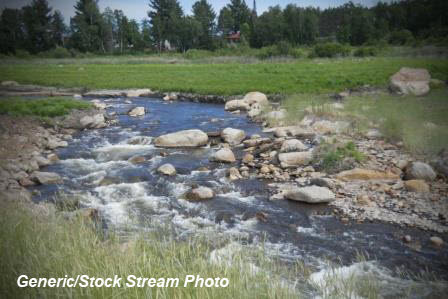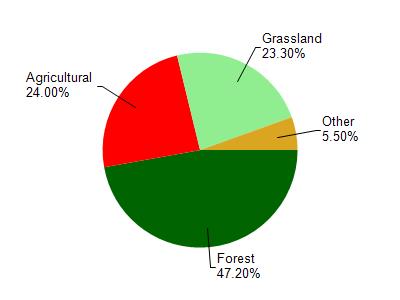
2.75 Miles
0 - 2.75
Cool-Cold Mainstem, Cool-Cold Headwater
2024
Good
Crawford
Yes
No
No
Fish and Aquatic Life
Overview
Nederlo Creek, also known as Johnstown Creek, is located in north central Crawford County.
This stream flows in a north easterly direction for 4.1 miles before reaching Tainter Creek
north of Gays Mills. Nederlo Creek has a gradient of 27 feet per mile and drains forested
hillsides and agricultural valleys. Nederlo Creek is a Class II trout stream upstream of
Freeman Road for 2.1 miles and Class III downstream of Freeman Road for 2.0 miles.
The most recent survey, conducted in 1998, documented a small brown trout population and a
very diverse community of forage fish species. At the time, sand and silt made up nearly 50%
of the stream bottom followed by cobble (41%) and small amounts of gravel and boulder. The
majority of in-stream cover consisted of aquatic vegetation and some boulders. Habitat seems
to be the limiting factor for trout in Nederlo Creek. Streambank pasturing of livestock contributes
greatly to the sediment problems of the stream. Nederlo Creek would benefit from
the purchase of streambank easements from willing sellers and the restoration of in-stream
habitat. WDNR records indicate that Nederlo Creek was stocked with brown trout yearly from
1959 to 1995. Brook trout have been stocked since 1999. Access to Nederlo Creek is from
one road crossing and a WDNR easement.
From: Ripp, Coreen, Koperski, Cindy and Folstad, Jason. 2002. The State of the Lower Wisconsin River Basin. PUBL WT-559-2002. Wisconsin Department of Natural Resources, Madison, WI.
Date 2002
Author Cynthia Koperski
General Condition
Water quality of Nederlo Creek was evaluated in 2020 and 2022; phosphorus and fish data indicate a healthy system. This stream segment is on the Healthy Waters List and is not considered impaired.
Date 2021
Author Ashley Beranek
Condition
Wisconsin has over 84,000 miles of streams, 15,000 lakes and milllions of acres of wetlands. Assessing the condition of this vast amount of water is challenging. The state's water monitoring program uses a media-based, cross-program approach to analyze water condition. An updated monitoring strategy (2015-2020) is now available. Compliance with Clean Water Act fishable, swimmable standards are located in the Executive Summary of Water Condition in 2018. See also the 'monitoring and projects' tab.
Reports
Management Goals
Wisconsin's Water Quality Standards provide qualitative and quantitative goals for waters that are protective of Fishable, Swimmable conditions [Learn more]. Waters that do not meet water quality standards are considered impaired and restoration actions are planned and carried out until the water is once again fishable and swimmable
Management goals can include creation or implementation of a Total Maximum Daily Load analysis, a Nine Key Element Plan, or other restoration work, education and outreach and more. If specific recommendations exist for this water, they will be displayed below online.
Monitoring
Monitoring the condition of a river, stream, or lake includes gathering physical, chemical, biological, and habitat data. Comprehensive studies often gather all these parameters in great detail, while lighter assessment events will involve sampling physical, chemical and biological data such as macroinvertebrates. Aquatic macroinvertebrates and fish communities integrate watershed or catchment condition, providing great insight into overall ecosystem health. Chemical and habitat parameters tell researchers more about human induced problems including contaminated runoff, point source dischargers, or habitat issues that foster or limit the potential of aquatic communities to thrive in a given area. Wisconsin's Water Monitoring Strategy was recenty updated.
Grants and Management Projects
Monitoring Projects
| WBIC | Official Waterbody Name | Station ID | Station Name | Earliest Fieldwork Date | Latest Fieldwork Date | View Station | View Data |
|---|
| 1185700 | Nederlo Creek | 10013676 | Nederlo Creek Station 2-Ne 1/4 Ne 1/4 Sec. 7- | | | Map | Data |
| 1185700 | Nederlo Creek | 10013671 | Nederlo Creek Section B-Se 1/4 Nw 1/4 Sec. 7-Starts At Freeman Rd. Bridge Crossing. | 5/14/1997 | 1/1/2015 | Map | Data |
| 1185700 | Nederlo Creek | 10011656 | Nederlo Creek - Nederlo Creek Station 1 Quad Bridge Crossing | | | Map | Data |
| 1185700 | Nederlo Creek | 10010355 | Nederlo Creek - Nederlo Creek Remap 120-X | 11/7/1999 | 10/26/2019 | Map | Data |
| 1185700 | Nederlo Creek | 10013670 | Nederlo Creek Section A-Ne 1/4 Nw 1/4 Sec. 7 | | | Map | Data |
| 1185700 | Nederlo Creek | 10013675 | Nederlo Creek Station 1-Ne 1/4 Se 1/4 S5-Approx. 500' Upstream Of Confluence Of Tainter Creek | 10/20/2002 | 10/9/2024 | Map | Data |
| 1185700 | Nederlo Creek | 10010356 | Nederlo Creek - Nederlo Creek Remap 120-B | | | Map | Data |
| 1185700 | Nederlo Creek | 10013669 | Nederlo Creek Section A1-Nw 1/4 Nw 1/4 Sec. 8-Starts At Farm Crossing. | | | Map | Data |
| 1185700 | Nederlo Creek | 119076 | Nederlo Creek at Freeman Rd Bridge Site #120b | 6/24/2003 | 10/23/2019 | Map | Data |
| 1185700 | Nederlo Creek | 10013667 | Nederlo Creek Station 1-Se 1/4 Se 1/4 Sec. 5 | 1/1/2015 | 1/1/2015 | Map | Data |
| 1185700 | Nederlo Creek | 120075 | Nederlo Creek - Nederlo Creek Site #120x | 6/24/2003 | 10/31/2003 | Map | Data |
|

Watershed Characteristics
Nederlo Creek is located in the Reads and Tainter Creeks watershed which is 135.69 mi². Land use in the watershed is primarily forest (47.20%), agricultural (24%) and a mix of grassland (23.30%) and other uses (5.50%). This watershed has 339.00 stream miles, 221.66 lake acres and 1,867.13 wetland acres.
Nonpoint Source Characteristics
This watershed is ranked High for runoff impacts on streams, Not Ranked for runoff impacts on lakes and High for runoff impacts on groundwater and therefore has an overall rank of High. This value can be used in ranking the watershed or individual waterbodies for grant funding under state and county programs.However, all waters are affected by diffuse pollutant sources regardless of initial water quality. Applications for specific runoff projects under state or county grant programs may be pursued. For more information, go to surface water program grants.
Nederlo Creek is considered a Cool-Cold Mainstem, Cool-Cold Headwater under the state's Natural Community Determinations.
Natural communities (stream and lake natural communities) represent model results and DNR staff valiation processes that confirm or update predicted conditions based on flow and temperature modeling from historic and current landscape features and related variables. Predicated flow and temperatures for waters are associated predicated fish assemblages (communities). Biologists evaluate the model results against current survey data to determine if the modeled results are corect and whether biological indicators show water quaity degradation. This analysis is a core component of the state's resource management framework. Wisconsin's Riverine Natural Communities.
Cool (Cold-Transition) Mainstem streams are moderate-to-large but still wadeable perennial streams with cold to cool summer temperatures. Coldwater fishes are common to uncommon, transitional fishes are abundant to common, and warm water fishes are uncommon to absent. Headwater species are common to absent,
mainstem species are abundant to common, and river species are common to absent.
Cool (Cold-Transition) Headwaters are small, usually perennial streams with cold to cool summer temperatures. Coldwater fishes are common to uncommon (<10 per 100 m), transitional fishes are abundant to common, and warm water fishes are uncommon to absent. Headwater species are abundant to common, mainstem species are common to absent, and river species are absent.